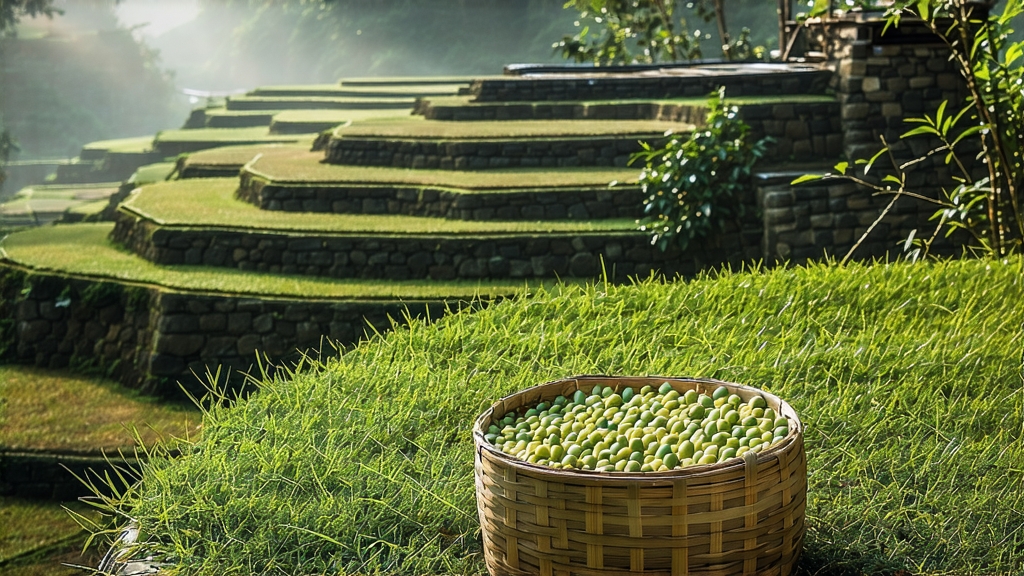
Hidden high above the Sichuan Basin, where the Min River carves misty corridors between emerald peaks, lies Meng Ding Mountain, the cradle of the world’s oldest cultivated tea garden. Among the clouds that coil around its ancient terraces, a shy golden bud has been plucked for more than twelve centuries: Meng Ding Huang Ya, the “Yellow Bud of Meng Ding.” Once sealed into bamboo tubes and rushed to the Tang-dynasty court, this tea still carries the perfume of imperial ceremony, yet remains largely unknown outside China. To meet it is to taste the slow alchemy of time, humidity and human patience that defines the elusive family of yellow teas.
History: from monk to monarch
Legend credits the Zen master Wu Lizhen with planting the first seven tea bushes on Meng Ding in 53 BCE, making the mountain the birthplace of cultivated tea. By the Tang era (618-907 CE) local chronicles already speak of “yellow sprouts” whose downy tips turned golden during a secretive warming process. Song emperors so coveted the tea that annual harvests were escorted to Chang’an by armed cavalry; a single brick equaled a civil servant’s monthly salary. After the Ming court shifted its taste to green leaf, Meng Ding Huang Ya retreated into monastic obscurity until 1959, when Chinese tea scientists rediscovered the technique in the archives of Ganlu Temple. Today only 300 mu (20 hectares) of certified heritage bushes remain, perched between 800 m and 1,200 m where Sichuan’s perennial fog filters UV light and coaxes slow, amino-rich growth.
Micro-terroir: why the mountain tastes like orchid
Meng Ding’s north-facing slopes act as a natural refrigerator, locking morning dew into the narrow valleys. The soil is a friable purple sandstone laced with fossilized shells—remnants of an ancient seabed—that drains quickly yet holds trace minerals. Night temperatures can drop 10 °C below daytime highs, forcing the plant to convert starches into fragrant terpenes. The result is a leaf that already smells faintly of orchid even before it is touched by fire or human hand.
Plucking: one bud, one leaf, before the cicadas sing
The picking window opens for barely ten days around Qingming (early April) when the bud is still shorter than the accompanying leaf. Experienced pluckers use a “sparrow’s beak” motion, snapping the stem without squeezing the dew inside. Each kilo of finished tea requires 45,000 such tips, gathered between 5 a.m. and 9 a.m. while the mountain cicadas are still drowsy. Leaves that arrive at the factory after 10 a.m. are rejected; the rising sun activates oxidative enzymes that would blur the tea’s signature green-yellow spectrum.
Craft: the art of “men huang” – smothering to gold
Yellow tea’s identity rests on a unique micro-fermentation step called men huang (literally “sealing yellow”). After a brief withering under shade cloth, the buds are wok-fired at 160 °C for four minutes, hot enough to kill green enzymes yet gentle enough to keep moisture at 55 %. While still steaming, they are piled in linen sacks only 7 cm thick—any deeper and the heap would sour; any thinner and the yellow would never emerge. Over the next 48 hours the sacks are turned every 90 minutes, allowing residual heat and humidity to coax a mild, non-enzymatic oxidation. Chlorophyll degrades into pheophytin, catechins dimerize, and a golden pigment blankets the leaf. Finally the tea is hand-roasted again over a bamboo brazier fueled by local oak whose smoke carries hints of coconut. A master roaster judges readiness by ear: when the crackle shifts from popcorn to pine nut, the buds are lifted and cooled within eight seconds.
Leaf appearance & aroma
Finished Meng Ding Huang Ya resembles tiny golden fishhooks, each tip still crowned by a single pale hair. Dry aroma is a duet of fresh corn silk and mountain orchid; once warmed in a gaiwan it releases steamed yam, toasted sesame and a whisper of Sichuan pepper that tingles the nose without sneeze.
Water philosophy: softness over swagger
The tea prefers water with 30-50 ppm dissolved solids—slightly softer than most spring waters. High mineral content dulls the orchid top note, while distilled water makes the liquor feel hollow. In Chengdu tea houses, collectors trek to the glacial springs of Qingcheng Mountain, filling clay amphorae that keep water at